Orthopedic Foundation for Animals (OFA) Testing
OFA Testing focuses mostly on orthopedic and physical abnormalities, though genetic testing can also be registered through them for the public to see. Some of these tests are preformed by general practice veterinarians, some require specialist veterinarians, and some require submitting information to the veterinarians employed by OFA to determine results. OFA testing should be VERY important to any reputable breeder. Recommended tests depends on each breed. I will focus on the tests important for Miniature American Shepherds and Miniature Australian Shepherds.
Hip Dysplasia
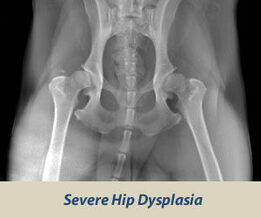
This is probably the most common and most important test among most breeds! Hip Dysplasia is a results of many factors. There are genetic predispositions to hip dysplasia which is what responsible breeders are working to steer away from and NOT proliferate.
However, there are also environmental factors that can influence a dog developing hip dysplasia such as too much exercise and joint impact when young. There are also plenty of cases where both genetic AND environmental factors influence the onset of hip dysplasia. Some dogs are unlucky and struggle with HD (hip dysplasia) from a young age. Other's don't develop until they are much older. Either way, it is a breeder's responsibility to check their breeding dogs at a mature age of around 1.5 years to 2 years or older before proceeding with any litters from that dog.
Hip Dysplasia is painful and can really affect the quality of a dog's life and mobility. Surgeries may be an option but are expensive with a long recovery. Pain medication and joint supplements are usually used chronically (long term). Life-span is usually shortened because of the lack of longevity to deal with this disease.
However, there are also environmental factors that can influence a dog developing hip dysplasia such as too much exercise and joint impact when young. There are also plenty of cases where both genetic AND environmental factors influence the onset of hip dysplasia. Some dogs are unlucky and struggle with HD (hip dysplasia) from a young age. Other's don't develop until they are much older. Either way, it is a breeder's responsibility to check their breeding dogs at a mature age of around 1.5 years to 2 years or older before proceeding with any litters from that dog.
Hip Dysplasia is painful and can really affect the quality of a dog's life and mobility. Surgeries may be an option but are expensive with a long recovery. Pain medication and joint supplements are usually used chronically (long term). Life-span is usually shortened because of the lack of longevity to deal with this disease.
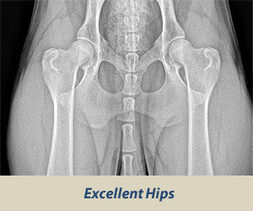
Testing: Radiographs of the hips in a specific position are sent in OFA for three different veterinarians to rate. The results can vary from Excellent, Good, Fair, Mild Dysplasia, and Severe Dysplasia. Take note of the difference in the ball-and-socket joint in both radiograph examples.
Note: Another test that can be used and often times takes into account laxity in the joint, is called PennHip. This test is sufficient as well as long as the dog is not bred with poor results.
Pictures credit to the Orthopedic Foundation for Animals:
www.ofa.org/diseases/hip-dysplasia
Note: Another test that can be used and often times takes into account laxity in the joint, is called PennHip. This test is sufficient as well as long as the dog is not bred with poor results.
Pictures credit to the Orthopedic Foundation for Animals:
www.ofa.org/diseases/hip-dysplasia
Elbow Dysplasia
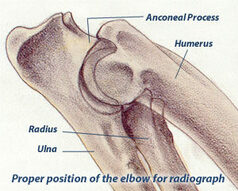
This test is usually done alongside hip dysplasia since final results can be submitted after 2 years of age. Elbow dysplasia has 3 known causes. All three causes are anatomical abnormalities of the elbow which may include a coronoid of the ulna, a condyle of the elbow joint, or the anconeal process.
Same as hip dysplasia, there are both genetic and environmental factors to the disease such as rate of weight gain or exercise. This disease is also painful and generally needs chronic pain medication with the onset of pain. Signs of pain or the disease can arise at any age. This, too, can negatively affect quality of life and mobility.
Testing: Radiographs of both elbows in a specific position are submitted to the veterinarians at OFA to rate. Results vary between Normal or Grade I, II, or III Elbow Dysplasia.
Picture credit to Orthopedic Foundation for Animals
https://www.ofa.org/diseases/elbow-dysplasia
Same as hip dysplasia, there are both genetic and environmental factors to the disease such as rate of weight gain or exercise. This disease is also painful and generally needs chronic pain medication with the onset of pain. Signs of pain or the disease can arise at any age. This, too, can negatively affect quality of life and mobility.
Testing: Radiographs of both elbows in a specific position are submitted to the veterinarians at OFA to rate. Results vary between Normal or Grade I, II, or III Elbow Dysplasia.
Picture credit to Orthopedic Foundation for Animals
https://www.ofa.org/diseases/elbow-dysplasia
Eye CAER Exam
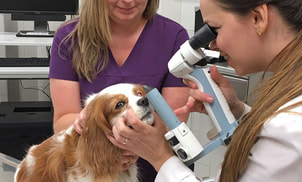
This health test requires an examination of the eyes by a veterinarian specialized in ophthalmology. This exam checks for dogs with several genetic and non-genetic diseases of the eyes. Our puppies are examined before they are considered for our program. Then, this test should be repeated once a year to continue to check for the onset of disease as some issues do not present until a later age.
The examining ophthalmologist fills out and OFA form describing with he/she did or did not find. Results can vary but ideal results would be "Normal" right and left eyes. PPM/ breeder notations are acceptable for some conditions. Picture credit to University of Illinois.
The examining ophthalmologist fills out and OFA form describing with he/she did or did not find. Results can vary but ideal results would be "Normal" right and left eyes. PPM/ breeder notations are acceptable for some conditions. Picture credit to University of Illinois.
Patellar Luxation
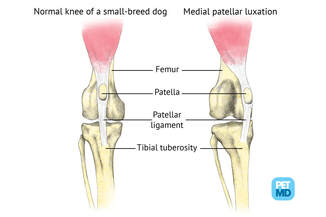
This test is preformed by any general veterinarian by a physical exam. Patellar luxation is a painful problem where the patella, or the bone that sits on the knee, slides in and out of the patellar groove. This bone sliding in and out of the knee-cap is very uncomfortable and often causes dogs to limp and require anti-inflammatories and sometimes corrective surgery.
This condition can be genetic as well as exercise induced, especially while young. It is generally more common in smaller breeds. If the dog has patellar luxation, it can either the right, left, or both and can slide medially or laterally. We prefer our breeding dogs to be free of this condition. Picture credit of PetMD and compares the normal patella to a dislocated or luxated patella.
This condition can be genetic as well as exercise induced, especially while young. It is generally more common in smaller breeds. If the dog has patellar luxation, it can either the right, left, or both and can slide medially or laterally. We prefer our breeding dogs to be free of this condition. Picture credit of PetMD and compares the normal patella to a dislocated or luxated patella.
Cardiac Exam
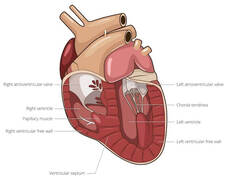
This health test can be preformed by both a general veterinarian or a cardiac specialist. The extent of the test depends on the breed and the heart conditions that the specific breed faces. For my breed, Miniature American Shepherds, we are not faced with many cardiac abnormalities. Therefore, we have a veterinarian preform this test by doing a physical exam and listening to the heart. If concerns arise, a follow-up with a cardiac specialist or echocardiogram can then be preformed.
